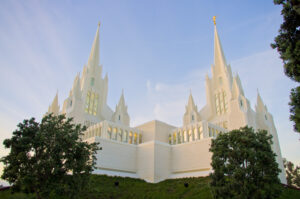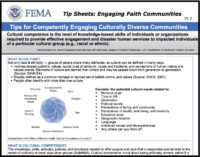In this tip sheet, you will discover foundational information to help you interact with Mormon leaders. It is part of a set of tools and training for FEMA to help disaster response professionals engage with faith communities. Much of the information also can help students, researchers, government agencies, non-profits and businesses learn about and develop relationships with communities. Click here for the PDF version of this tip sheet.
Religion Called: The Church of Jesus Christ of Latter-day Saints (LDS) or Mormonism
Adherents Consider Themselves: Christian and are called Mormons/Latter-day Saints/Saints
House of Worship: Meetinghouse (or, church/chapel)
First Point of Contact: Branches: Branch President or Wards: Ward Bishop
Religious Leader: No ordained leaders; Branch President or Ward Bishop
Spoken Direct Address: Males: use “Elder” (“Bishop” for bishops); Females: use “Sister”
Physical Interaction: Handshake O.K. across genders
HOUSE OF WORSHIP
- Meetinghouse: Place where congregations attend regular Sunday worship services (also called a chapel or church).
- Temple: The Church of Jesus Christ of Latter-day Saints operates approximately 138 temples worldwide. Open only to church members in good standing for marriages and other sacred ceremonies (closed Sundays).
RELIGIOUS LEADERS
Ordained/Commissioned/Licensed Leaders
No formal clergy; designated leaders play specific roles; priesthood and the role of bishop is limited to men. Women’s leadership takes other forms.
Lay Leaders
Local churches are led and staffed by unpaid lay leaders. Branch presidents and Bishops have similar roles including both spiritual and administrative duties. Both are assisted by two counselors.
Melchizedek Priesthood: Worthy adult males who have received authority from God to perform sacred ordinances and to lead in the Church. Men who hold this priesthood belong either to the elders quorum or high priests group within a ward.
POINTS OF CONTACT
- Local: Branch (smaller congregation), led by branch president and two counselors or Ward (large congregation of 300 or more members), led by Bishop and two counselors (called bishopric). Branch/ward councils may have Welfare Committees which coordinate welfare of members including during disaster. Some wards maintain a Bishops Storehouse
with food and supplies for congregation members in need. - Regional: Stake (composed of 5-12 wards and/or branches), led by stake president and two counselors. There are also public affairs directors worldwide who work within the geographical area served by a temple.
- National: The First Presidency & Quorum of the Twelve Apostles.
NVOAD MEMBERSHIP AND CORE CAPABILITIES IN DISASTER
National Voluntary Organizations Active in Disaster (NVOAD) is a nonprofit, nonpartisan, membership based organization that serves as the forum where organizations share knowledge and resources throughout the disaster cycle. FEMA DSA team members should check with their VAL to determine whether local or regional VOADs exist in their operational area.
LDS Charities provides humanitarian assistance worldwide and its Mormon Helping Hands volunteer organization provides community service and disaster relief volunteer teams. Mormon Helping Hands have led post-disaster recovery activities such as muck-outs and home rebuilds.
The Church of Jesus Christ of Latter-day Saints also promotes emergency preparedness and has a network of HAM radio operators in each ward to maintain communications in post-disaster or emergency settings.
ETIQUETTE QUICK TIPS
Greeting
When introducing yourself to a religious leader, use formal religious titles unless instructed otherwise.
Male missionaries should be addressed as “Elder” while female missionaries should be addressed as “Sister”. Bishops may be addressed as “Bishop”.
Physical Interaction
In approaching Mormon leaders, gestures common in the U.S. such as shaking hands are generally acceptable. It is also acceptable for men and women to shake hands.
Other
Ask before participating in worship services. Ushers can help with customs, dress, and etiquette.
GOVERNANCE / JUDICATORY
Church of Jesus Christ of Latter-day Saints (LDS) is the main denomination. Smaller breakaway and reform denominations (which differ in governance and some points of belief and practice) do exist, both to the right and the left of the mainstream.
The Latter-Day Saints’ leadership has a hierarchical male priesthood and is organized as follows:
- First Presidency: Highest governing body in the Church. Is made up of the prophet and his two counselors. Presides over areas in the United States and Canada. Pronouncements are authoritative.
- Quorum of Twelve Apostles (also considered prophets): Second-highest governing body in the Church. Quorums of the Seventy: Work under direction of the Quorum of Twelve Apostles and Presidency of the Seventy to proclaim the gospel and build up the Church. Currently eight Quorums of the Seventy with up to 70 members each.
- Presidency of the Seventy: Seven members of the First or Second Quorum of the Seventy called by the First Presidency.
- Presiding Bishopric: President of the Aaronic priesthood throughout the Church; serves under the First President to administer the temporal affairs of the Church.
MEETING LOGISTICS AND SCHEDULING
Scheduling and Holidays
Christmas (commemoration of the birth of Jesus) and Easter (feast marking the resurrection of Jesus) are important celebrations in the Church as well as national holidays.
Other Church-specific holidays include:
- July 24: Pioneer Day (commemorates the arrival of Mormon pioneers in the Salt Lake Valley in Utah).
- April 6: Date the Church of Jesus Christ of Latter-day Saints was reorganized by the Prophet Joseph Smith.
Mormons refrain from work on Sundays and scheduling meetings on Sundays should be avoided. Many Mormon families observe a family home evening weekly (often on Monday).
Food
- Observant LDS members abstain from alcoholic, caffeinated beverages, and tobacco; they are encouraged to consume wholesome herbs, fruits within season, and grains; consumption of meat should be moderate.
- Fasting (no food or drink for 24 hours) is required once each month; ill people are not required to fast.
Logistics
- Local churches are encouraged to prepare detailed emergency preparedness and response plans, based on principles contained in Providing in the Lord’s Way. Branch Welfare Committees are identified as the coordinators if disaster strikes. Individual families are encouraged to prepare three months of food and financial resources to sustain themselves during
difficult times or in emergency circumstances.
DRESS
Dress for most Mormons and Mormon leadership is professional, conservative clothing consistent with western-style business attire. Church leaders typically wear ties and white dress shirts. Mormon missionaries can be identified by their black nametags worn on outer garments. Observant Mormons wear a sacred undergarment (temple garment) with short sleeves and kneelength legs, which is kept out of sight.
Responders and disaster recovery personnel should wear conservative clothing if attending services at a Mormon chapel. While there is no specific dress code required by Mormons for worship, Church members are generally counseled to wear their “Sunday best”.
ABOUT MORMONISM
Most adherents consider themselves Christian and are called Mormons or Latter-day Saints or Saints. The religion is called the Church of Jesus Christ of Latter-day Saints (also known as Mormonism). It derives from revelations received by the Prophet Joseph Smith in upstate New York, and set out in The Book of Mormon. It embraces many distinctive beliefs and practices.
- It sees itself as restoring the primitive Church of the New Testament, and teaches a form of apostolic succession.
- It teaches that God (often called Heavenly Father), who is omniscient, has a material body.
- It is centered on Jesus Christ as the firstborn of God, and teaches substitutionary atonement through Christ. It teaches as well about the Holy Ghost (or Holy Spirit). Its explanation of the nature and interrelationship of Heavenly Father, Jesus Christ, and the Holy Ghost differs significantly from Trinitarian Christianity. Mormons believe God the Father, Jesus and the Holy Spirit are separate beings.
- Members are believed to be literal spiritual sons and daughters of a living Father in Heaven.
- Mortality is a probationary period in which people are to obey the Lord’s commandments given through ancient and current prophets, including presidents of the church.
Click here for the PDF version of this tip sheet.
The Engaging Faith Communities tip sheets were created through a collaboration between the DHS Center for Faith-based and Neighborhood Partnerships, the USC Center for Religion and Civic Culture, USC CREATE and the National Disaster Interfaiths Network. For further training, please see EMI course IS-505, which was also developed by this partnership.


